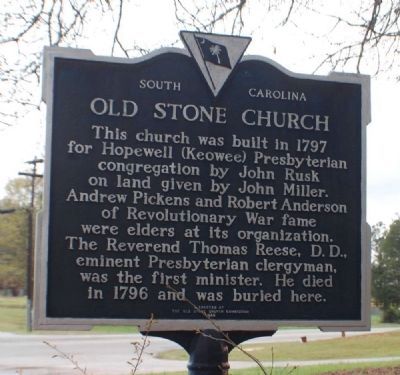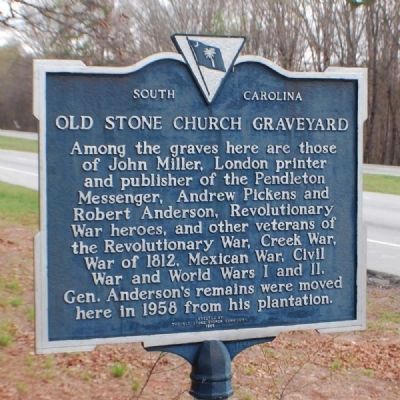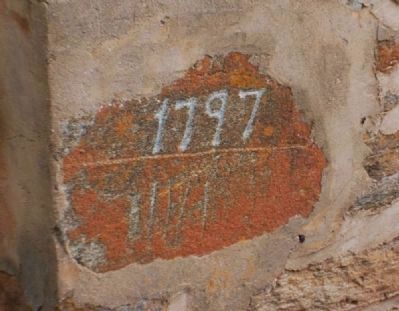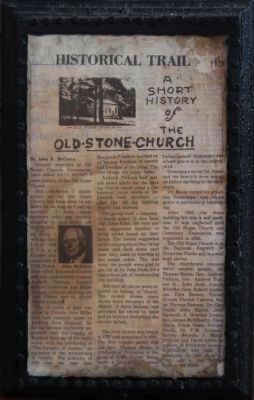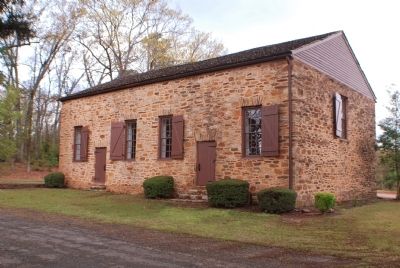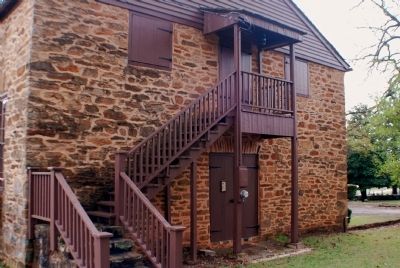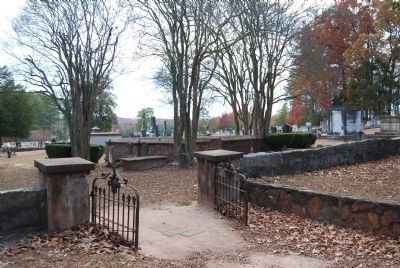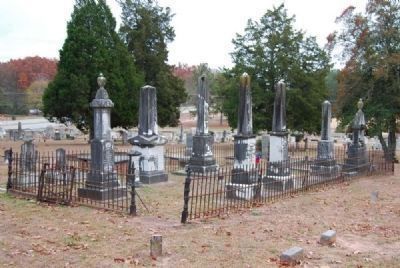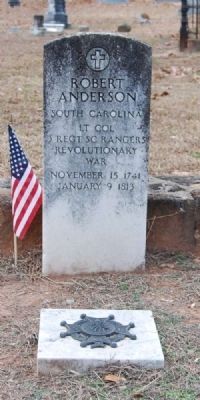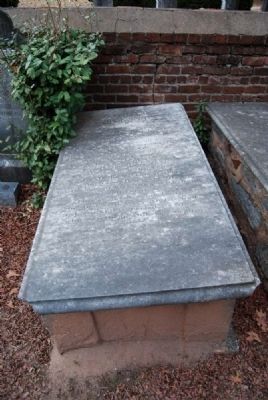Clemson in Pickens County, South Carolina — The American South (South Atlantic)
Old Stone Church / Old Stone Church Graveyard
Erected 1965 by Old Stone Church Commission. (Marker Number 39-3.)
Topics. This historical marker is listed in these topic lists: Churches & Religion • Colonial Era • War, US Revolutionary. A significant historical year for this entry is 1797.
Location. 34° 39.775′ N, 82° 48.868′ W. Marker is in Clemson, South Carolina, in Pickens County. Marker is at the intersection of Old Stone Church Road (State Highway 22) and Anderson Highway (U.S. 76), on the right when traveling east on Old Stone Church Road. Touch for map. Marker is in this post office area: Clemson SC 29631, United States of America. Touch for directions.
Other nearby markers. At least 10 other markers are within walking distance of this marker. The Old Stone Church (about 500 feet away, measured in a direct line); a different marker also named The Old Stone Church (about 500 feet away); Old Stone Church Confederate Memorial (about 500 feet away); Thomas Green Clemson Parkway (approx. 0.6 miles away); Blue Key National Honor Fraternity Gateway (approx. 0.8 miles away); "Widowmaker’s” Drill (approx. 0.8 miles away); Hanover House (approx. 0.8 miles away); a different marker also named Hanover House (approx. 0.9 miles away); a different marker also named Hanover House (approx. 0.9 miles away); Hunt Cabin (approx. 0.9 miles away). Touch for a list and map of all markers in Clemson.
Also see . . .
1. Old Stone Church and Cemetery. The Old Stone Church is significant architecturally as a masonry adaptation of meeting house architecture and as a representative of the early pioneer church in South Carolina. (Submitted on December 15, 2008, by Brian Scott of Anderson, South Carolina.)
2. Old Stone Church (Clemson). Old Stone Church is a church building built in 1802. When it was constructed, it was in the Pendleton District, South Carolina. (Submitted on July 4, 2009, by Brian Scott of Anderson, South Carolina.)
3. Robert Anderson. Robert Anderson (1741 – 1813) was a brigadier general in the colonial militia and a surveyor. (Submitted on July 4, 2009, by Brian Scott of Anderson, South Carolina.)
4. Andrew Pickens. Andrew Pickens (September 13, 1739 – August 11, 1817) was a militia leader in the American Revolution and a member of the United States House of Representatives from South Carolina. (Submitted on July 4, 2009, by Brian Scott of Anderson, South Carolina.)
5. Governor Andrew Pickens. Andrew Pickens, Jr. (December 13, 1779 – July 1, 1838) was an American military and political leader who served as the Democratic-Republican Governor of South Carolina from 1816 until 1818. (Submitted on July 4, 2009, by Brian Scott of Anderson, South Carolina.)
Additional commentary.
1. Old Stone Church and Cemetery - National Register Nomination Form (1971)
Construction of Old Stone Church began in 1797 to replace a log meeting house which was burned. The natural fieldstone rectangular structures with medium gable roof was completed in 1802. Six bays deep with high fenestration, the windows are the size of its doorways. Flat arches with slight radiation of voussoirs are over doors and windows. Exterior stairs lead to slave gallery at rear of church.
Interior is simple, unornamented befitting the period; the wooden benches, raised wooden pulpit, pine floor, hand-hewn exposed beans evident in roof.
Statement of Significance
October 13, 1789, the congregation of Hopewell-Keowee Church asked to be taken into the Presbytery of South Carolina. Church named Hopewell from Treaty of Hopewell (1785) between settlers and Cherokee enacted in part by General Andrew Pickens and Keowee from a branch of the Seneca River. Later called Old Stone Church.
The first building having been destroyed by fire, a new church was built 1797-1802 by John Rusk.
Important politically and militarily for men of prominence instrumental in church's organization and buried in cemetery. Among these are: Revolutionary War Generals Andrew Pickens and Robert Anderson - principle founders and elders; Colonel Andrew Pickens (War of 1812) - elder, Governor of South Carolina.
In the area social/humanitarian, it is noteworthy for the Old Stone Church and Cemetery Commission, organized in the 1890s, which realized the importance of the building itself and its association with distinguished men in South Carolina history. A wall was put around graveyard and repairs made to preserve the old building which had not been used since the 1830s. This Commission remains active in maintaining the church and cemetery.
Importance
in religion/philosophy stems from its use as a religious center; the Reverend Thomas Reese, distinguished scholar, patriot, and first South Carolina minister to receive the degree of Doctor of Divinity, who served as pastor 1792-1796; church member "Printer" John Miller, publisher of South Carolina Gazette and Advertizer (Charleston), Junius Letters, and Miller's Weekly Messenger (Pendleton), whose essay "The Influence on Religion in Civil Society" testifies to the quality of South Carolina literature in 1788.
Significant architecturally as representative of the early pioneer church in South Carolina; masonry adaptation of meeting house architecture; built of local materials with outstanding exterior and interior masonry and woodwork craftsmanship.
— Submitted July 4, 2009, by Brian Scott of Anderson, South Carolina.
2. Old Stone Church
By 1790 some of the Presbyterians in the county had organized a second Presbyterian church. General Andrew Pickens could not have been connected with the Richmond-Carmel church for any long period of time, for on October 13, 1789, he, Colonel Robert Anderson, Robert Henderson, Robert McCann, and John Wilson appealed to the Presbyterian Synod for preaching supplies for both Richmond and Hopewell, the latter taking its name after the home of the general, but apparently it had no church building. According to a History of Old Stone Church (1905) by Richard Newman Brackett of Clemson College, plans for erection of a church were made at an organizational meeting held in the Pendleton Courthouse in 1790, and a little log meeting house was erected that year near the home of Ezekiel Pickens (son of General Andrew Pickens) on the vicinity of Clemson. Members of the committee first appealing for supplies for the new church were all Revolutionary War veterans with the possible exception of young Robert McCann, an ancestor of Governor James L. Orr. The pulpit and the pews for the log church were presented by General Pickens, and in this crude log-edifice the Hopewell-Keowee congregation met to worship for five or six years.
The Reverend John Simpson, a graduate of Princeton, was an early supply pastor for Hopewell, Carmel, and other early Presbyterian churches. A Revolutionary War veteran, Simpson was a stern old fighting pastor, reputed to have been the first to introduce hymns to South Carolina Presbyterians, supplementing Psalms. Dr. Thomas Reese, also a Princeton graduate, was supply pastor from 1792 until 1796. Dr. Reese was more scholarly than Simpson, and a fluent writer. He once expressed the opinion that the Hopewell congregation was more liberal in sentiment than members of Carmel, although Hopewell was not as large.
About 1796, the log church was burned in a forest fire and plans were made to build another church house. This time it was to be constructed of stone. Printer John Miller donated a tract of sixteen and three-fourths acres of land a few miles south of the original site and nearer Pendleton Village. John Rusk, the amiable stone mason who had come from Ireland in 1791, was commissioned to undertake the construction work. Oddly enough, the Hopewell congregation did not receive title to the land donated by Miller until after his death. Records show that the title was made by his sons, John and Crosby Miller, who inherited their father's property.
Old Stone Church was built by subscription. Principal contributors, as listed in church records, were Andrew Pickens, Robert Anderson, George Reese, William Owens, a Mr. Joseph (?) Whitner, a General (John Baylis ?) Earle, and a Mr. (John Ewing ?) Calhoun. The Calhouns, or Colhouns, and probably the Earles, were originally Presbyterians, but the Calhoun family later became members of St. Paul's Episcopal Church, while the Earles became staunch Baptists.
The foundation of the church was laid in 1797. Meanwhile the Hopewell pastor, Dr. Thomas Reese, died and was buried in the Old Stone Church cemetery before the church was built. The work went forward year after year, the solid walls rising on a simple quadrangular foundation, with huge windows and a door that was small by comparison. The building was completed around the turn of the century. There is some conflict of opinion as to the exact date of completion. Services may have been conducted in the church in 1800, although it is generally believed that the building was not completed until 1802. General Pickens contributed the walnut pulpit and church pews.
Pickens was later to take the lead in the founding of another Presbyterian church (Bethel Presbyterian, 1805) near his retirement home, the red House, at Tamassee, but he held a deep affection for Old Stone Church. He served as one of the original ruling elders, together with General Robert Anderson and Major Dickson, and the Pickens family and their descendants worshipped there; for some 100 years Pickens family descendants continued to be buried in the cemetery on the gentle slope beside the church.
To this period also belongs a religious venture of national significance in which Pickens had a part. Pickens and his son Ezekiel, together with Thomas Jefferson and Benjamin Franklin, joined a group of about 100 others to publish a family Bible to be printed in America. It came off the press in Philadelphia around year 1800, and the subscribers' names are listed in the forward. To one of these American-produced bibles were transferred
the Pickens family records, including the parents' birthdates and the records of their twelve children.
Early pastors of Hopewell and Carmel were the Reverend James McElhenney, builder of Clergy Hall (a two-story, four-room house that was enlarged and became Fort Hill, home of John C. Calhoun); the Reverend James Hillhouse; the Reverend Anthony W. Ross; and the Reverend Aaron Foster. The pastors divided their time between Hopewell and Carmel until the Reverend Hillhouse became pastor. He and Ross were employed by the Hopewell Society two-thirds of the time.
Apparently one of the earliest academies in the Up Country, known as Hopewell Academy, was conducted at Old Stone Church. This was a classical academy that quite probably existed prior to 1800. Members of the Board of Trustees in 1802 were the Reverend McElhenny, General Robert Anderson, General Andrew Pickens and Colonel (General) J.E. Earle, with E. Reese as rector. One of the teachers was Robert Breckenridge. An 1807 issue of Miller's Weekly Messenger announced Breckenridge's marriage to Eleanor Richards and stated that Breckenridge was an English teacher at Hopewell Academy.
In 1824 a new frame church was built in Pendleton Village and Old Stone Church was abandoned. The name Hopewell was eventually dropped, and today the church is known as Pendleton Presbyterian Church.
In Old
Stone Church Cemetery are the graves of many distinguished early settlers of Pendleton District. General Andrew Pickens, his son, Governor Andrew Pickens, and other members of his family rest there; John Ruck, father of Senator Thomas Jefferson Ruck of Texas and an ancestor of former Secretary of State Dean Rusk; Joseph Witner (Whitner), father of Judge Joseph N. Whitner; and others.
A story of particular interest centers around the grave of Turner Bynum, who was killed in 1832 in a duel with Benjamin Franklin Perry, provisional governor of South Carolina after the Civil War. Perry grew up on his father's plantation on the Tugaloo River, near the home of Colonel Benjamin Cleveland, and studied law under Judge Baylis John Earle in Greenville. He became the editor of a Greenville weekly newspaper, The Mountaineer. During the height of the nullification controversy, Turner Bynum, a young man of brilliant intellect and an advocate of John C. Calhoun's position supporting nullification, was recruited to publish a competing newspaper opposing the Unionist views expressed in Perry's newspaper. The political differences between the two journalists became so bitter that Bynum challenged Perry to a duel.
The duel took place one rainy afternoon on an island in the Tugaloo River near Hatton's Ford. Though he was an expert with firearms, Bynum was mortally wounded in

Photographed By Brian Scott, November 28, 2008
10. Miller Family Marker
Central Piece:
John Miller
Pioneer Printer and Publisher born in
London England. Died in Pendleton S.C.
1730-1809
An English Gentleman
----------
John Miller 2nd
London England Pendleton S.C.
1770-1828
----------
John Miller 3rd
Pendleton S.C. Bachelors Retreat
1794-1876
----------
In these noble men their wives and their descendants who rest in this sacred soil is this stone lovingly dedicated.
Pioneer Printer and Publisher born in
London England. Died in Pendleton S.C.
1730-1809
An English Gentleman
----------
John Miller 2nd
London England Pendleton S.C.
1770-1828
----------
John Miller 3rd
Pendleton S.C. Bachelors Retreat
1794-1876
----------
In these noble men their wives and their descendants who rest in this sacred soil is this stone lovingly dedicated.
— Submitted July 4, 2009, by Brian Scott of Anderson, South Carolina.
3. Reverend Thomas Reese
About the year 1790, circular letters were written by Mr. Austin, editor of the American Preacher, to distinguished preachers of all denominations, requesting them to furnish two sermons annually, that a selection might by made from them, and published as specimens of pulpit eloquence in the United States. One of these letters was addressed to Dr. Thomas Reese, and he sent on two sermons
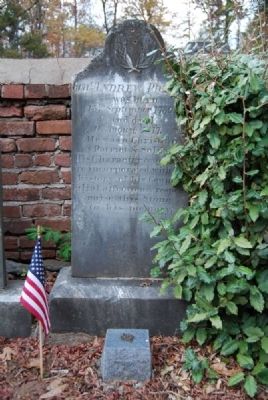
Photographed By Brian Scott, November 28, 2008
11. Gen. Andrew Pickens Tombstone
was born
15th September 1739
and died
11th August 1817. He was a Christian
a Patriot & Soldier.
His Character & age
are incorporated with the
history of his Country.
Filial affection & respect
raise this Stone
to his memory.
Dr. Reese's theological opinions were founded solely on the authority of the Scriptures, and of course Orthodox.
His appearance in the pulpit was graceful and dignified, his style flowing and elegant. He was in the habit generally of writing out his sermons with great care, and seldom, if ever, took the manuscript to the pulpit. His preaching was of the extempore kind, adding to the mature reflections of the study, the powers of his native oratory. His flowing tears, and often suppressed voice, told the feelings of the heart, anxious only for the salvation of souls and the glory of God. Like Paul, he warned his hearers day and night with tears. His success in his ministerial labors evince the power and presence of the Holy Spirit. It is a subject of painful regret, that the examples of such men as Dr. Reese, Edwards, Whitfield, and others should be lost, and that their successful manner of awakening and instructing their hearers, should be supplanted by the cold and prosy reading of sermons from the pulpit, which so effectually lulls to sleep a waiting audience, of binds them up, in the present day.
Dr. Reese was also an ardent lover of sacred music, and was careful to have his congregation will instructed in this devotional part of worship. His own melodious voice, mingled with those of the whole congregation, filled God's court with sounding praise. He did not trust this part of divine worship to a choir, which, as the proxy of the congregation, might sing praises to God;
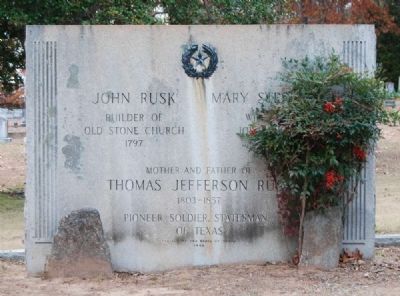
Photographed By Brian Scott, November 28, 2008
13. John Rusk Tombstone
Erected by the State of Texas
Erected by the State of Texas
Note the original tombstones for John and Mary Rusk at the base of the newer one. In addition to being the builder of the Old Stone Church, Rusk was the father of Thomas Jefferson Rusk, one of two South Carolinians who signed the Texas Republic's Declaration of Independence from Mexico.
As a teacher, he had a peculiar facility of communicating knowledge, and the happy talent of commanding respect without severity. For a period of five or six years of his life, and that too past the meridian, exclusive of his performing the regular duties of a pastor, preaching on the sabbath and lecturing to the colored part of his congregation, he superintended a small farm, and attended to a large classical school, with but little assistance, in the course of the week. And it is well recollected that during more than one season, he preached two sermons on the Sabbath, and performed, besides, the other duties mentioned above.
Dr. Reese was "given to hospitality," and evinced his benevolence by visiting the sick and afflicted, and relieving the wants of the poor and needy. Having read many medical authors, and being conversant with physicians, he had acquired a pretty general knowledge of Southern diseases, and in his visits to the sick frequently imparted not only spiritual consolation, but medical aid. This was the more acceptable, as at that time there were no physicians near him. In the winter of 1792 and 1793 he removed from Salem to Pendleton district, South Carolina, being among the first who removed from the low country to the upper.
Having settled near Pendleton village, he took charge of two churches, one near Seneca river in the neighborhood of Generals Pickens and Anderson, the other church some ten or twelve miles distant. In these he labored some years; but the climate of the upper country not agreeing with his constitution, his health declined. He was attacked with Hydrothorax in the patter part of his life, and such was the nature of his disease, that he did not lie down for weeks previous to his death. He bore this affliction with great patience and resignation to the will of his divine Master, and died in 1796, aged 54 years. His remains lie in the grave-yard, attached to the Old Stone church, near the village of Pendleton.
Chalcellor James of South Carolina, is his Life of Marion, speaking of Dr. Reese, says: "In comtemplating the meek and unobtrusive manners of this eminent servant of the Most High, we do not hesitate to say he was a pattern of Christian charity, as nearly resembling his Divine Master as has been exhibited by any of his contemporary fellow-laborers in the Gospel. It may truly be said, in conclusion, of this excellent man, that he lived esteemed, and died lamented by an extensive circle of warm and devoted friends." (Source: History of the Presbyterian Church in South Carolina by George Howe (1883), pgs 638-639.)
— Submitted July 5, 2009, by Brian Scott of Anderson, South Carolina.
Credits. This page was last revised on June 23, 2022. It was originally submitted on April 18, 2008, by Brian Scott of Anderson, South Carolina. This page has been viewed 4,583 times since then and 149 times this year. Last updated on July 21, 2008, by Brian Scott of Anderson, South Carolina. Photos: 1, 2, 3, 4. submitted on July 4, 2009, by Brian Scott of Anderson, South Carolina. 5, 6. submitted on April 18, 2008, by Brian Scott of Anderson, South Carolina. 7. submitted on December 13, 2008, by Brian Scott of Anderson, South Carolina. 8, 9, 10, 11, 12, 13. submitted on July 4, 2009, by Brian Scott of Anderson, South Carolina. • Craig Swain was the editor who published this page.
